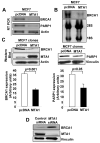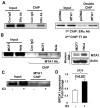MTA1-mediated transcriptional repression of BRCA1 tumor suppressor gene
- PMID: 17922032
- PMCID: PMC2705285
- DOI: 10.1038/sj.onc.1210839
MTA1-mediated transcriptional repression of BRCA1 tumor suppressor gene
Abstract
Metastasis-associated tumor antigen 1 (MTA1), a component of the nucleosome remodeling and deacetylating (NuRD) complex is routinely upregulated in several cancers. In the present study, we investigated the potential role of MTA1 in BRCA1 transcriptional repression and subsequent chromosomal instability. MTA1-NuRD complex was found to negatively regulate BRCA1 transcription by physically associating with an atypical estrogen-responsive element (ERE) on the BRCA1 promoter. Moreover, MTA1 and HDAC complex recruited to the ERE of BRCA1 promoter in an ER alpha-dependent manner. Accordingly, BRCA1 protein levels were enhanced by silencing of either MTA1 expression or by treatment with the specific histone deacetylase inhibitor trichostatin A. MTA1's strong repressive effects on BRCA1 expression was supported by our observation that cells stably overexpressing MTA1 showed centrosome amplification which has been long implicated as a phenotype for BRCA1 repression. Accordingly, overexpression of BRCA1 in cells stably over expressing MTA1 resulted in restoration of normal centrosome numbers. Together, these findings strongly implicate MTA1 in the transcriptional repression of BRCA1 leading to abnormal centrosome number and chromosomal instability.
Figures







Similar articles
-
The role of the MTA family and their encoded proteins in human cancers: molecular functions and clinical implications.Clin Exp Metastasis. 2009;26(3):215-27. doi: 10.1007/s10585-008-9233-8. Epub 2008 Dec 31. Clin Exp Metastasis. 2009. PMID: 19116762 Review.
-
Transcriptional repression of oestrogen receptor by metastasis-associated protein 1 corepressor.Nat Cell Biol. 2001 Jan;3(1):30-7. doi: 10.1038/35050532. Nat Cell Biol. 2001. PMID: 11146623
-
Metastasis-associated protein 1 drives tumor cell migration and invasion through transcriptional repression of RING finger protein 144A.J Biol Chem. 2012 Feb 17;287(8):5615-26. doi: 10.1074/jbc.M111.314088. Epub 2011 Dec 19. J Biol Chem. 2012. Retraction in: J Biol Chem. 2015 Mar 13;290(11):6751. doi: 10.1074/jbc.A114.314088. PMID: 22184113 Free PMC article. Retracted.
-
Metastasis-associated protein 1 (MTA1) is an essential downstream effector of the c-MYC oncoprotein.Proc Natl Acad Sci U S A. 2005 Sep 27;102(39):13968-73. doi: 10.1073/pnas.0502330102. Epub 2005 Sep 19. Proc Natl Acad Sci U S A. 2005. PMID: 16172399 Free PMC article.
-
Metastasis-associated protein 1/nucleosome remodeling and histone deacetylase complex in cancer.Cancer Res. 2012 Jan 15;72(2):387-94. doi: 10.1158/0008-5472.CAN-11-2345. Cancer Res. 2012. PMID: 22253283 Free PMC article. Review.
Cited by
-
The role of the MTA family and their encoded proteins in human cancers: molecular functions and clinical implications.Clin Exp Metastasis. 2009;26(3):215-27. doi: 10.1007/s10585-008-9233-8. Epub 2008 Dec 31. Clin Exp Metastasis. 2009. PMID: 19116762 Review.
-
The subcellular distribution and function of MTA1 in cancer differentiation.Oncotarget. 2014 Jul 15;5(13):5153-64. doi: 10.18632/oncotarget.2095. Oncotarget. 2014. PMID: 24970816 Free PMC article.
-
Structure, expression and functions of MTA genes.Gene. 2016 May 15;582(2):112-21. doi: 10.1016/j.gene.2016.02.012. Epub 2016 Feb 9. Gene. 2016. PMID: 26869315 Free PMC article. Review.
-
MTA1 expression correlates significantly with ER-alpha methylation in breast cancer.Tumour Biol. 2012 Oct;33(5):1565-72. doi: 10.1007/s13277-012-0410-7. Epub 2012 May 29. Tumour Biol. 2012. PMID: 22644675
-
ATP-dependent chromatin remodeling complexes as novel targets for cancer therapy.Adv Cancer Res. 2014;121:183-233. doi: 10.1016/B978-0-12-800249-0.00005-6. Adv Cancer Res. 2014. PMID: 24889532 Free PMC article. Review.
References
-
- Bagheri-Yarmand R, Talukder AH, Wang RA, Vadlamudi RK, Kumar R. Metastasis-associated protein 1 deregulation causes inappropriate mammary gland development and tumorigenesis. Development. 2004;131:3469–3479. - PubMed
-
- Baker KM, Wei G, Schaffner AE, Ostrowski MC. Ets-2 and components of mammalian SWI/SNF form a repressor complex that negatively regulates the BRCA1 promoter. J Biol Chem. 2003;278:17876–17884. - PubMed
-
- Balasenthil S, Broaddus RR, Kumar R. Expression of metastasis-associated protein 1 (MTA1) in benign endometrium and endometrial adenocarcinomas. Hum Pathol. 2006;37:656–661. - PubMed
-
- Chabalier C, Lamare C, Racca C, Privat M, Valette A, Larminat F. BRCA1 downregulation leads to premature inactivation of spindle checkpoint and confers paclitaxel resistance. Cell Cycle. 2006;5:1001–1007. - PubMed
Publication types
MeSH terms
Substances
Grants and funding
LinkOut - more resources
Full Text Sources
Molecular Biology Databases
Miscellaneous

